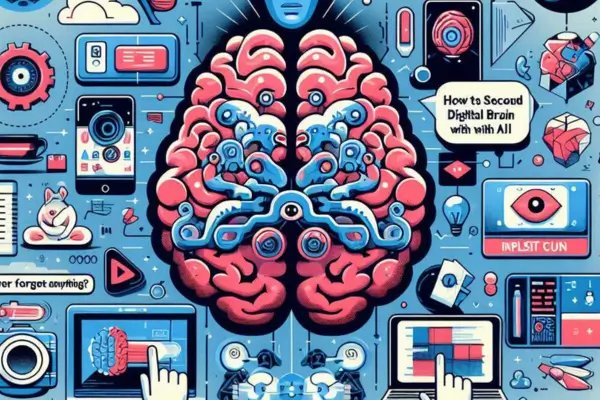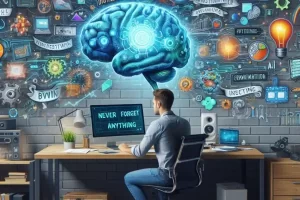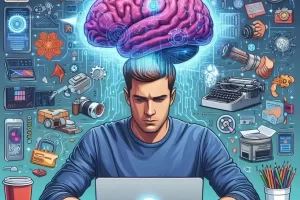Setting goals is easy — sticking to them and achieving them is where most people struggle. Too often, we create goals that are too vague, too ambitious, or disconnected from our daily lives. But with the support of a second brain and artificial intelligence (AI), you can create a goal system that helps you stay aligned, track progress, and adjust as life evolves.
In this article, you’ll learn how to set meaningful, achievable goals and use your second brain with AI to support clarity, consistency, and completion.
Why Most Goals Fail
Let’s start with why goal-setting often doesn’t work:
- Goals are not specific or measurable
- There’s no system to track progress
- They’re forgotten after the initial motivation fades
- Goals don’t connect to your identity or purpose
- You try to do too much at once
A second brain solves this by storing, organizing, and reviewing your goals regularly. AI helps by turning your intentions into systems and keeping you on track.
Define What a “Good” Goal Looks Like
Start by creating goals that are:
- 🎯 Specific
- ✅ Measurable
- 💪 Achievable
- 🔗 Relevant to your life and values
- ⏳ Time-bound
SMART goals are useful — but you can go deeper.
Ask AI:
“Rewrite this goal to make it SMART and identity-based.”
“What personal values does this goal reflect?”
“Suggest metrics for tracking this goal over time.”
Now your goal isn’t just a wish — it’s a target with a system.
Create a Goal Tracker in Your Second Brain
Build a space in Notion, Obsidian, or Tana to store and monitor your goals. For each one, track:
- Goal title and category (Health, Career, Personal, etc.)
- Start and end dates
- Current progress
- Milestones
- Action steps
- Notes and reflections
- Alignment with your vision
Let AI help:
“Generate a 90-day plan to reach this goal.”
“Break this goal into milestones and weekly tasks.”
“Add tags to organize goals by life area and priority.”
This keeps your goals visible and structured.
Connect Your Goals to Your Daily and Weekly Plans
Your goals should shape your everyday choices. Use your second brain to link goals to:
- Daily to-dos
- Weekly planning dashboards
- Time blocks
- Projects and habits
- Journal entries
Ask AI:
“What actions this week will move me closer to my top 3 goals?”
“Generate a weekly plan that balances my health and career goals.”
“Which tasks from my to-do list align with my current goals?”
You’ll stay connected to your goals without overwhelm.
Track Progress and Celebrate Small Wins
Success builds momentum. Use your second brain to:
- Update progress weekly
- Note micro-wins
- Record what worked
- Celebrate consistency, not perfection
Let AI assist:
“Summarize my progress on this goal in the last 2 weeks.”
“What positive behaviors contributed to this milestone?”
“How can I celebrate this progress in a meaningful way?”
Tracking progress keeps your motivation alive.
Review and Realign Regularly
Not all goals stay relevant — and that’s okay.
Create monthly or quarterly review routines to ask:
- Is this goal still aligned with my values?
- What’s blocking my progress?
- Do I need to pause, revise, or drop this goal?
- What lessons am I learning?
Use AI to reflect:
“Which goals have stalled and why?”
“What mindset patterns are helping or hurting my progress?”
“Suggest edits to this goal based on my recent journal entries.”
This allows your goals to evolve with you.
Make Goal-Setting Part of Your Identity
Goals stick when they align with how you see yourself.
For example:
- “I write every day” instead of “I want to publish a book”
- “I’m someone who honors their body” instead of “Lose 10 pounds”
- “I learn something new each week” instead of “Read 12 books this year”
Ask AI:
“Rewrite this outcome-based goal as an identity-based habit.”
“What daily behaviors reflect this goal as part of who I am?”
“How can I reinforce this identity in my weekly plan?”
This turns goals into part of your lifestyle — not a temporary challenge.
Build a Feedback Loop That Supports Consistency
Use your second brain and AI to create a loop of:
- Planning your next steps
- Tracking your actions and outcomes
- Reflecting on what’s working or not
- Adjusting based on feedback
Automate reminders and reviews:
“Check in on your Q2 goals this Friday.”
“Remind me to update goal progress every Sunday.”
“Summarize my current goals and suggest the next best action.”
Now your second brain becomes your goal accountability partner.
Real-Life Example: The Goal-Driven Professional
You’re managing multiple personal and professional goals — fitness, content creation, income, and learning.
Your second brain includes:
- A clean dashboard with your top 5 active goals
- Linked projects and habits that drive each one
- Weekly AI-generated progress summaries
- Identity-based affirmations tied to each goal
- Monthly reflections to update or replace outdated goals
You’re not just working hard — you’re working with purpose and precision.
Final Thoughts: You Don’t Need More Goals — You Need Better Systems
Goal-setting is a start. But goal systems are what get you to the finish line.
With your second brain and AI:
- Your goals stay visible and actionable
- Your actions align with your values
- You stay flexible and self-aware
- You track and celebrate the small wins
- You become the person who finishes what they start
Dream big. Plan clearly. Review often. And let your system carry you to your goals — one step at a time.




